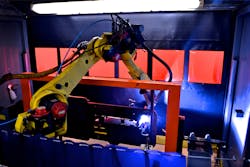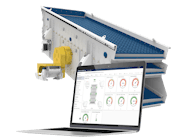As industrial facilities have become increasingly automated, they’ve been faced with new risks that require new protocols. As such, significant changes in industrial safety standards have taken place across North America in the last several years.
Today’s technologically complex factories require highly trained employees. Therefore, it’s more important than ever that those plants adopt new safety standards that keep up with their new technology. One of the best ways to ensure a safe work environment is by conducting a thorough risk assessment, especially when new automated processes have recently been added. This isn’t just a suggested best practice. When the Robotics Industrial Association (RIA) developed RIA15.06, proper risk assessments became mandatory for when new equipment or processes are added to a facility.
Synchronizing standards with RIA15.06
This standard references ISO 10218-1 & 2, which addresses robots, robot systems and integration. The revised rule follows the same international standards already in place in Europe, making life easier for manufacturers and end users.
RIA15.06 requires superior hazard identification accounting for not only robot motion, but the task being performed. Additionally, it requires validation and verification of the safety systems employed, and of the designs that incorporate protective measures for the robot cell and the operator. Because every robot system is different, requiring risk assessments is an important step in protecting employees.
One of the biggest changes that has come with the RIA standard has to do with safety-rated motion and allowing for advanced programmable safety devices to be used. Software can allow for "safety-rated" control of various aspects of the robot’s function, limiting the area in which the robot operates and the speed of robot motion. This is a departure from older standards in that programmable safety controls were not allowed.
This standard means the physical footprint of new robot cells can shrink. Before RIA15.06, engineers designing these systems had to guard for the maximum space, speed and load of the robot. Coupled with the proper point-of-interaction safety devices, significant floor space savings can be realized.
Presence-sensing devices have limitations
Light curtains, laser scanners and other presence-sensing devices are commonly used and widely accepted methods of machine guarding in manufacturing facilities from Tier 1 automotive to small machine shops and fabrication facilities. The automated process ceases once the safety device’s infrared beam is tripped.
In many instances these devices provide acceptable safety. However, they are not always the best choice in all applications, especially after a risk assessment is performed.
Limiting hazard exposure even further
Light curtains may be the right choice in some applications, as they can limit exposure to the hazard and reduce risk. But, a fast-acting automated barrier door or roll-up curtain may be the better choice because it can eliminate exposure to the dangerous movement of the machine and secondary hazards produced by the process, potentially eliminating risk and the severity of exposure.
Coupled with safety interlocks (up to PLe, Cat. 4 per EN ISO 13849-1 when integrated properly), automated barrier doors and roll-up curtains offer an increased level of protection for point-of-operation guarding. Not only do they restrict access to the process, they also contain secondary hazards such as smoke, flash, splash, mist or flying debris associated with automated welding operations by placing a barrier between machine operators and machine movement. These types of guards are an ideal alternative to light curtains and other presence-sensing devices in many situations.
Benefits of automated barrier doors
Due to the nature of a properly interlocked automated barrier door, certain aspects of the U.S. Occupational Safety and Health Administration’s (OSHA) safety distance formula become moot because there is no depth penetration factor — thus allowing the safeguard to be placed much closer to the hazardous area. That means less space dedicated to a "safety zone," consequently reducing the manufacturing cell’s footprint. This space savings is a huge benefit in most facilities. The smaller safety zone may also make for a better ergonomic situation for the machine operator by limiting required motion and helping increase productivity, an essential in today’s competitive market.
The elimination of accidental entry into the cell is another benefit of interlocked automated barrier doors. Because they provide safeguarding that can be seen (unlike the invisible infrared beams of presence-sensing devices), the opportunity for accidental work stoppage is greatly reduced. The physical separation they provide is a clear visual indicator that the machine operator needs to be on task.
Improved safety and additional floor space
Automated barrier doors are quickly establishing themselves as a popular safety device option for points-of-interaction. While the main purpose of these doors is to contain fumes, sparks, smoke, mist, flying debris, excess noise and other common manufacturing process by-products, they can minimize the physical footprint of the robotic cell by eliminating the safety zone that is required by light scanners/light curtains. The most advanced roll-up automated barrier doors offer high-speed, high-cycle technology, as well as PLe, Cat. 4 hold-down mechanisms and safety-rated, non-contact interlock switches and controls.
Most automated doors function from the top down, but some have been designed to operate from the ground up. This design allows machine operators to easily interact with the process using overhead cranes to load and unload large, heavy parts. They are also a great option for interaction points that have a limited space.
New standards reflect new technology
Now that these new standards are matching up better with state-of-the-art technology, they are mitigating the risks workers face and can actually improve efficiencies in facilities throughout the U.S.
As new regulations like RIA15.06 are adopted, it is important to keep up on the latest and greatest safety technologies available to match the right product to the right process, taking not only potential machine hazards into consideration, but also the task being performed. Advances in design and available technology make automated barrier doors an ideal option to guard a machine and protect operators, ultimately increasing productivity and the level of safety for years to come.
John Ritter is the Rite-Hite Doors product manager. For more than 17 years, Ritter has worked with Rite-Hite, a manufacturer of loading dock equipment, industrial doors, safety barriers, HVLS fans, industrial curtain walls, and more, all designed to improve safety, security, productivity, energy consumption and environmental control. For more information, visit www.ritehite.com.



